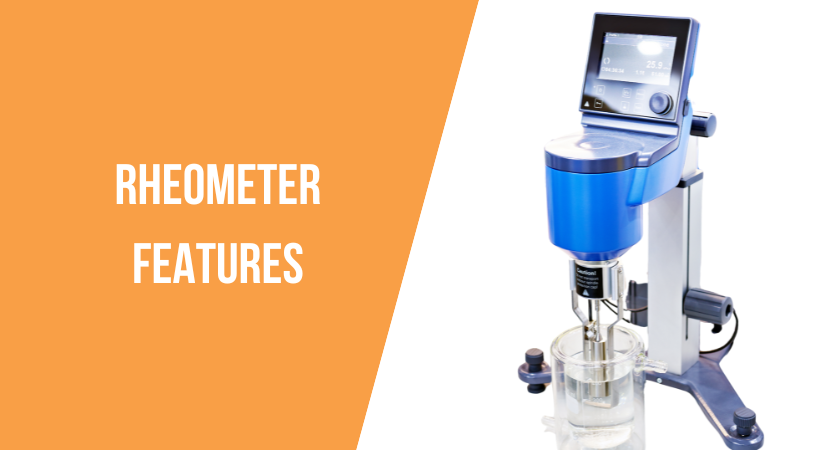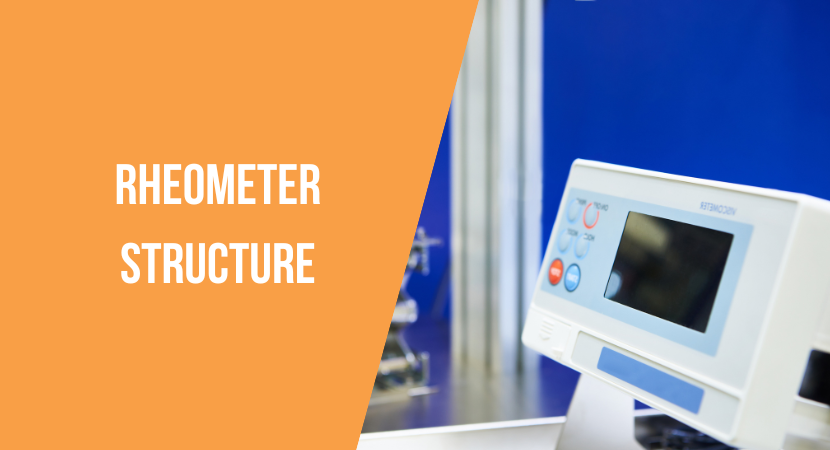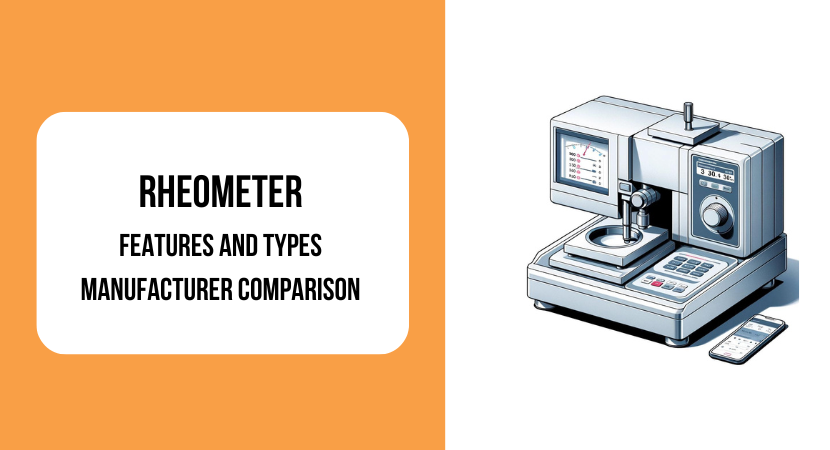However, it’s crucial to note that each rheometer possesses unique characteristics. Hence, selecting a machine that aligns with specific purposes and site requirements is paramount.
In this article, we will take a closer look into the distinctive features, price range, and structure of commonly used rheometers. We will also explore the pros and cons of each type, selection criteria, and provide a comprehensive list of major manufacturers.
With the information presented in this article, you will be able to choose the most suitable machine for your needs, so please read on until the end.
目次
What is a rheometer? Characteristics/principles and price range of measurement

First, we will take a look at the basic features and principles of rheometers, as well as their price ranges.
Basic features and principles of rheometer
A rheometer is a machine that quantitatively measures rheological properties.Used to understand how solids deform (e.g. elastic, plastic deformation), how liquids and solutions flow (e.g. viscosity), etc.In particular, it is often used to evaluate the response of materials such as viscosity and elasticity to external forces (stress). It has a wide range of applications, including materials research and development, quality control, and production process optimization.
In addition to the rheometer, there is a machine called the B-type viscometer that measures viscosity, but while the B-type viscometer allows you to select only a specific number of rotor rotations, the rheometer allows you to freely select the rotation speed.
The rheometer works in the following sequence:
- A rotating or vibrating part applies a constant stress to the sample, inducing a sample response (deformation or flow)
- A sensor detects the response of the sample and measures its deformation and flow rate
- Measured data is analyzed by control and data processing software to determine rheological properties such as viscosity of the material
Rheometer price range
The price of a rheometer varies greatly depending on the type and performance, but it can generally be purchased for about one million yen.You can divide the price range into three categories:
Rheometer price range
Low price range: Approximately 10,000 USDFeatures: Capable of basic rheology measurements and texture analysis, suitable for educational use, small-scale research, and quality control. With its simple operability and minimal functionality, it is ideal for beginners and laboratories with limited budgets.
Medium price range: Approximately 40,000 USD
Features: Suitable for research and industrial applications that require higher precision and scalability, and equipped with advanced technology and functions to accommodate specific measurement conditions and property analysis. The price range is suitable for use in mid- to large-scale laboratories and manufacturing industries.
High price range: Approximately 75,000 USD
Features: Capable of fast and highly accurate measurements, suitable for specific high-load tests and complex rheological analyses. It is ideal for environments that require advanced analysis, such as research and development of special materials, quality control in advanced industries, and new product design.
So far, we have explained the basic features and mechanisms of rheometers, as well as their price ranges. In the next chapter, we will explain the basic structure of a rheometer.
By understanding the structure after grasping the basic features and mechanisms, it will be easier to understand the characteristics of each type. Please continue reading.
Explaining the basic structure of a rheometer

Now, we will begin to explain the basic structure of the rheometer. Although we will use a rotary rheometer as an example, a rheometer generally consists of the following elements:
- Rotor
- Stator
The roles of each are as follows.
Rotor
The rotor is the moving part of the rheometer, driven by a motor. This part is used to directly contact the sample to be measured and apply shear force to the sample. Shearing is the application of force in the direction that something is cut.There are several types of rotor shapes (disk, cone, cylinder, etc.), which are selected depending on the type of sample used and the purpose of measurement.
By rotating the rotor at a constant speed relative to the sample, it is possible to shear and flow the sample and measure its response (strain and fluidity). During the measurement, the torque (rotational force) and rotational speed applied to the rotor are precisely controlled, which allows the evaluation of rheological properties such as viscosity and elasticity of the sample.
This rotor part can be a vibrating device (vibration type) or an extrusion device (capillary) depending on the type of rheometer.
Stator
Stator as the name suggests, it is a fixed part within the rheometer that acts as a “reference point” when the rotor rotates. It provides a static environment to hold the sample and observe how it reacts to the forces applied by the rotor.Although it depends on the type of sample to be measured and the measurement conditions, the stator is generally a flat plate or a matching cylinder.
Stators also often have temperature control capabilities, allowing the sample temperature to remain constant or vary according to specific temperature control adjustments. This makes it possible to evaluate the effect of temperature on the rheological properties of materials.
In the case of a capillary rheometer, this part changes to a capillary tube. The viscosity is determined by pushing the sample through a thin tube (capillary) and measuring the pressure drop.
So far, we have explained the basic structure of a rheometer using a rotary rheometer as an example.
The basic structure of a rheometer has now been established, but the types of rheometers differ depending on variations in this structural part. In the next chapter, we will review four types of rheometers and explain the advantages and disadvantages of each.
4 types of rheometers and their uses, advantages and disadvantages

Let us now explain the types of rheometers and the advantages and disadvantages of each. Rheometers can be broadly divided into the following four types.
Rotary rheometer
A rotary rheometer uses a cup that holds a specific sample and a rotating cylinder (rotor) placed inside the cup to precisely characterize the flow and deformation properties of materials. This is the device for analysis. This device makes it possible to accurately measure the relationship between the shear stress applied between the cup and rotor and the resulting shear rate of the material.Advantages
- Flow characteristics can be examined in detail
- Can be measured under conditions suitable for the fluid to be measured
- Can be measured in conditions close to the actual usage environment
Disadvantages
- Requires a relatively large amount of sample
- Fluid properties may change
Advantages
Since the rotation speed and shear stress can be set by the user, the flow characteristics of non-Newtonian fluids (objects whose viscosity changes depending on the applied force) can be investigated in detail.By using rotors of various shapes and sizes, measurements can be made under the optimal conditions for the fluid being measured. By controlling the temperature and pressure or applying external force during measurement, measurements are taken under conditions close to the actual usage environment.
Disadvantages
Measurements require a relatively large amount of a sample. Additionally, measurements may take time, and in some cases, the properties of the fluid may change.Measurement results are affected by rotor shape and size, cup-to-rotor spacing, etc., so care must be taken when accurately recording measurement conditions and comparing results with other devices.
Vibration rheometer
A vibratory rheometer uses a vibrator inserted into a sample to apply vibrations at a constant frequency to accurately determine the relationship between shear stress and shear rate on a material. It is an advanced device for measuring. This method allows simultaneous evaluation of the viscous and elastic responses of materials, providing a comprehensive understanding of the viscoelastic properties of the sample.Advantages
- Low risk of changing fluid properties
- Real-time measurement possible
- Requires less sample volume
Disadvantages
- Unable to change shear rate and investigate fluid properties in detail
- Increasing cost of equipment due to addition of sensors
Advantages
Measurements take less time and there is less risk of changing fluid properties. This allows real-time measurements that quickly respond to changes in sample viscosity and temperature. In addition, the amount of sample required for measurement is small, and the influence of measurement conditions is small.In addition, a flat plate type vibrator causes less destruction to the sample structure, allowing for stable viscosity values and measurements that follow viscosity changes.
Disadvantages
It may not be possible to change the shear rate and investigate the flow characteristics of non-Newtonian fluids in detail.Additionally, measurement requires highly accurate excitation force sensors and temperature sensors, which can make the equipment expensive. Another point to consider is that measurement results are affected by the shape, size, and natural frequency of the resonator, so it is also necessary to accurately record and correct the measurement conditions.
Capillary rheometer
A capillary rheometer is a device that accurately measures the relationship between the pressure generated between a cylinder that holds a sample and a piston that pushes the sample through a capillary tube and the rate of extrusion of the substance. This measurement provides a detailed analysis of flow properties and viscosity, especially in highly viscous fluids and molten polymers.Advantages
- Can be measured with a small amount of sample
- Capable of measuring fluids flowing at high speed
- Can be assumed in conditions close to the actual usage environment
Disadvantages
- Increasing cost of equipment due to addition of sensors
- Regular maintenance required
Advantages
It is suitable for expensive samples because it can be measured with just a small amount.It is also suitable for measuring fluids that flow at high speeds because it can measure at high shear rates. By controlling the temperature and pressure or applying external force during measurement, measurements can be made in conditions close to the actual usage environment of the sample.
Disadvantages
Measurements require highly accurate pressure and temperature sensors, which can make the equipment expensive. Measurements also require a nozzle (which guides the fluid in a specific direction). They must be selected and cleaned according to the properties of the sample and measurement conditions.Measurement results are affected by nozzle shape, size, pressure loss, etc., so measurement conditions must be accurately recorded and corrected.
Texture analyzer
The Texture Analyzer is a versatile physical property testing machine for measuring the physical properties of various samples such as food, cosmetics, pharmaceuticals, and biomaterials. This device measures the relationship between test force and deformation by applying various loads such as tension, compression, and bending to the sample.Advantages
- Useful for quality control as the feel can be quantified
- Wide range of measurement targets
- Can be measured in conditions close to the actual usage environment
Disadvantages
- Requires a relatively large amount of sample
- Properties of the sample may change
Advantages
The feel and texture of foods and cosmetics can be quantified, which is useful for quality control.Since it can handle samples of various shapes and sizes, it has a wide range of measurement targets. By controlling the temperature and humidity or applying external force during measurement, measurements can be made in conditions close to the actual usage environment.
Disadvantages
Measurements require a relatively large amount of the sample. Additionally, the measurement takes time and the properties of the sample may change.Measurement results are affected by test conditions, so you must take care when accurately recording measurement conditions and comparing results with other equipment.
Up to this point, we have explained the characteristics and advantages and disadvantages of each rheometer.
In the next chapter, we will explain five criteria for choosing the most suitable machine for your company from among the many rheometers available. It is very important to understand the criteria when selecting your rheometer, so please read on.
How to choose? 5 points of rheometer comparison criteria

From here, we will explain the selection criteria when choosing a rheometer. The following five points should be considered when introducing a machine.
Hardness of object
The hardness of an object is an indicator of how well it resists external forces, and is one of the important criteria when choosing a rheometer. Depending on the hardness of the sample to be measured, a rheometer with an appropriate measurement mode (e.g. shear mode or extension mode) should be selected.Hardness is particularly important in understanding the properties of solid and semisolid samples. Rheometers can be used to evaluate the deformation and flow behavior of materials under various stress conditions, but for these stiff samples, a texture analyzer or similar may be required. On the other hand, if the material is soft, a rotating type or vibrating type is suitable.
Measured temperature
The best rheometer to choose will depend on the temperature range of the sample that needs to be measured. For example, if you need to make measurements at high temperatures, you should choose a device with highly adjustable temperature control capabilities.Additionally, the viscosity and viscoelasticity of the sample tend to change as the temperature changes, related to the hardness of the object.
For example, as the temperature increases, the sample flows more easily, its viscosity decreases, and its viscoelasticity decreases. In this case, a capillary rheometer is suitable. On the other hand, as the temperature decreases, the sample generally becomes more solidified, its viscosity increases, and its viscoelasticity increases. In this case, a vibration type is suitable.
Shear stress/extension stress
Changing the shear stress of the rheometer will change the flow curve of the sample and the results of dynamic rheological measurements. Therefore, the appropriate rheometer will vary depending on the nature of the measurement results you want to obtain.A flow curve is a graph that shows the relationship between shear stress and shear rate, and is used to evaluate the fluidity and yield value (the minimum stress required to change to a fluid state) of a sample. For example, in order for toothpaste to come out of the tube easily, it is important to have an appropriate yield value.
Dynamic viscoelasticity measurement is a method in which stress is measured by applying sinusoidal strain (deformation that changes in a sinusoidal waveform over time; related to an oscillatory rheometer) to a sample, and the elastic modulus and loss of the sample are measured. used to evaluate the rate.
When the shear stress is high, the sample flows easily and the shear rate becomes large in the flow curve. If high shear stress is required, a texture analyzer is suitable. Additionally, dynamic viscoelasticity measurements have a large phase difference between stress and strain, resulting in a high loss rate. Phase difference is the time difference between the applied stress and the material response (strain).
Shear rate
Shear rate is a measure of how quickly a sample deforms or flows and is one of the criteria to consider in rheometer selection.By choosing a rheometer with a wide range of shear rates, it is possible to evaluate the behavior of materials over a wide range of flow conditions from low to high speeds.
It is especially important when characterizing fluid flow and solid deformation. By using the appropriate rheometer for your sample, you can measure the response you are looking for. For example, if you require high shear rates, a capillary rheometer is suitable.
Frequency
Frequency is a particularly important parameter in oscillatory rheometer measurements, indicating the rate of vibration applied to the sample. By changing the frequency, you can study the time dependence and dynamic viscoelastic properties of materials.At higher frequencies, the elastic response of the sample becomes predominant, while at lower frequencies, the viscous response tends to become more prominent. Choosing a rheometer that covers the appropriate frequency range for your sample will give you a better understanding of the material’s behavior.
These are the five criteria for selecting a rheometer. In the next chapter, we will introduce a list of manufacturers that manufacture rheometers. Read on to find out which manufacturer is right for your company.
5 major manufacturers of rheometers

Let us now introduce the major companies that manufacture rheometers. After sorting out your company’s installation conditions and checking the five comparison criteria, it’s time to find a company that specializes in manufacturing rheometers.
5 major rheometer manufacturers
| Rotary rheometer | Vibrating rheometer | Capillary rheometer | Texture analyzer | |
|---|---|---|---|---|
| Anton Paar | ✔ | – | ✔ | – |
| TA Instruments Japan | ✔ | ✔ | – | – |
| Malvern Panalytical | ✔ | – | – | – |
| Thermo Fisher Scientific | ✔ | – | – | – |
| Imada | – | – | – | ✔ |
Anton Paar
Anton Paar is a manufacturer of precision measuring instruments founded in Austria in 1922. They are known as a world-class manufacturer in the field of viscosity and rheology measurements.We offer rotary rheometers and capillary rheometers. The MCR (Modular Compact Rheometer) series is especially famous.
Anton Paar’s strength is that it covers a wide variety of physical property measurement and analysis instruments such as density, concentration, refraction, viscosity, viscoelasticity, flash point, FTIR, and XRD.
Anton Paar rheometers are used in a wide variety of applications including food, cosmetics, pharmaceuticals, petroleum, paints and coatings, polymers, ceramics, building materials, metals, paper and biology.
TA Instruments Japan
TA Instruments Japan is a world-renowned manufacturer in the field of materials characterization, including rheology, thermal analysis, and microcaliparimetry. It was founded in the United States in 1990.We manufacture the Discovery Hybrid Rheometer (DHR) and ARES-G2 rotary rheometers and vibratory rheometers.
The DHR is a versatile rheometer capable of performing a variety of rheological measurements including controlled stress, strain, shear, vibration, rotational deformation, tensile deformation, and extensional deformation. ARES-G2 is a highly advanced rotary rheometer used for research and materials development.
The strengths of TA Instruments’ rheometers include the ability to acquire accurate and precise rheological data, easily and reproducibly load samples, meet a wide variety of experimental needs, and perform advanced characterization.
T.A. Instruments’ rheometers are used in a variety of industries including adhesives and sealants, agrochemicals, asphalt pavers, batteries and battery materials, food, paints, inks and coatings, personal care and household products, pharmaceutical materials, and polymers.
Malvern Panalytical
Malvern Panalytical is a world leader in analysis and measurement. Plc provides scientific equipment and services such as particle counters and X-ray analyzers. Based in London, the Japanese branch was established in 1980.Among other rheometers, Malvern Panalytical carries rotary rheometers.
The strength of Malvern Panalytical’s rheometers is that they are equipped with high-quality sensors and software to provide accurate and reproducible measurement results. They also provide ample support for maintenance and more.
Malvern Panalytical’s rheometers are used to evaluate food quality, such as texture and stability. For example, they can measure the fluidity and hardness of chocolate, the viscosity and gelation of yogurt, and the emulsification and separation of mayonnaise.
Thermo Fisher Scientific
Thermo Fisher Scientific is a leading global scientific services company offering advanced analytical instruments, reagents, consumables, software and more. Founded in 1989, the head office is located in Minato-ku, Tokyo.Materials science-related measurement instruments, including rheometers, are part of the product lineup, and precise rheological measurements help us understand material properties and contribute to the development of new materials and the improvement of existing materials. They handle rotary rheometers.
Their strengths lie in their comprehensive technological capabilities and wide product lineup. They provide products and services that meet the needs of laboratories and industries around the world.
Thermo Fisher Scientific rheometers are used in the chemical, food, pharmaceutical and biotechnology, cosmetics, and petroleum and energy industries.
Imada
IMADA is a manufacturer that specializes in load measurement, and provides products such as force gauges, load cells, measurement stands, and torque gauges. Founded in 1947, they have now expanded their sales network both domestically and internationally.Imada’s rheometer is a tabletop type and portable texture analyzer. This is a measuring instrument that can quantify the texture of food, and measurement conditions can be easily set by simply selecting the food type and standard.
Its strengths are the ability to acquire 1000 data per second, high accuracy of ±0.2% F.S., and the ability to perform precise texture tests. In addition, food measurements based on JIS, ISO, universal design food, and food standards for people with swallowing difficulties can be easily achieved.
Imada’s rheometers are used not only in the food industry, but also in the cosmetics and pharmaceutical industries.
Investing in your own Rheometer
A rheometer is an innovative device for precisely measuring the deformation properties of various materials. From our daily lives to industry, accurately understanding the behavior of materials is essential to improving product quality and meeting consumer expectations.There are several types of rheometers. Please consider installing a machine that suits your company’s purposes and use it to measure rheological properties.
Is the company really suitable for your company’s goals? Are you choosing the right model? Please feel free to contact us if you have any concerns.
Based on the differences between each product and company, we will suggest the company that best suits your purpose.
Contact JET Global
Additionally, A survey regarding this media service is currently being conducted. It only takes about three minutes, so please let us know what you think so we can improve your service experience.
Win an Amazon gift card!
“JET-Global” user survey in progress

